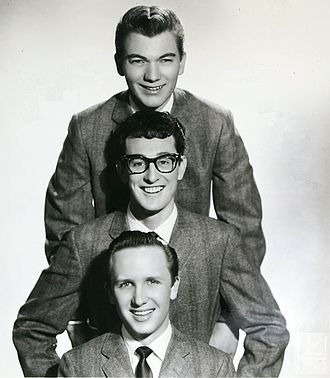
Buddy Holly and the Crickets in 1958
As part of my series of articles on band names, I thought it would be interesting to go back to the beginning of the band name itself. The folk music of American immigrants from Europe, known as Hillbilly, threw up a few interesting group names in the 1930s – notably the Skillet Lickers. Primarily, however, Hillbilly, or Country as it was known from the 1940s, was a style based around individual singers.
More influentially, into the 1950s black R&B musicians in the United States started adopting quirky collective nouns – The Orioles, The Penguins, The Crows.
In Texas, Buddy Holly, dutiful son of a religiously conservative family, secretly listened to black musicians on late night radio. Amongst them was New Orleans vocal group, The Spiders. Later, when he became a musician himself, Buddy had to think of a name for his own group. Using The Spiders’ name as his starting point, he searched through reference books on entomology, eventually finding his way towards a much less threatening insect, the cricket. Crickets are harmless little creatures, which under the cover of darkness, fill the night with their chirpy sound. The story of Buddy Holly is something similar, the story of a young man using a kind of camouflage to make forbidden music.
This camouflage was vital. In white dominated 1950s America, the music of black R&B musicians was a symbol of moral threat and a focus for bigotry. Philip Norman in his biography of Buddy Holly quotes from a leaflet distributed at the time, to restaurants and shops throughout the southern United States:
“NOTICE! STOP! Help save the Youth of America. Don’t buy Negro records. If you don’t want to serve Negros in your place of business, then don’t have Negro records on your jukebox or Negro records on the radio. The screaming, idiotic words and savage music of these records are undermining the morals of our white youth in America. Call the advertisers on radio stations that play this type of music and complain to them…”
If the Crickets wanted to write and play music inspired by black musicians, they could only do so by hiding in the linguistic long grass.

Beatles related graffiti – photographed during my visit to Abbey Road in 2005
Buddy Holly died in an air crash in 1959, but the musical force he helped set free continued to develop world-wide. By the early 1960s two young Liverpudlians, John Lennon and Paul McCartney, were trying to think of a name for their band. As Buddy Holly fans, they naturally followed tracks that Crickets made through dangerous social undergrowth. They decided to keep with the insect theme and become The Beatles. While the name Beetles had been on Buddy Holly’s own list of insect related name options, he realised that mainstream taste was not ready. It would take a few more years before Beatles would be acceptable, which even with its musically adapted spelling, suggested darker connotations of scuttle and scurry not seen with crickets. A style of music once symbolising sin and social breakdown was now becoming an accepted part of global society. Some bands even felt it was safe to call themselves The Spiders, major examples including a successful Japanese group formed in 1961, as well as a 1964 version of Alice Cooper’s band.

Ziggy Stardust and the Spiders From Mars – one of the first albums I ever bought
The Spiders as a band name probably had its greatest success in 1972, when David Bowie and The Spiders From Mars shot into the rock stratosphere. Now it seemed the world could fully accept a group of musicians named after the kind of creatures that Buddy Holly had to turn into crickets.
